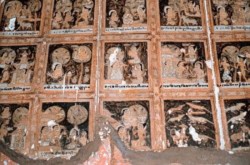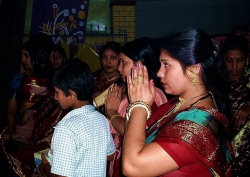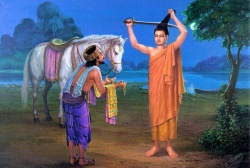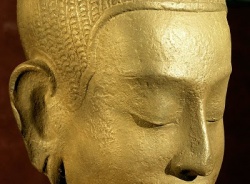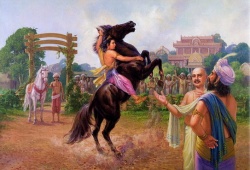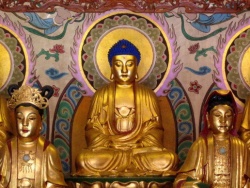Difference between revisions of "Jātaka"
m (Text replacement - "The Buddha" to "The Buddha") |
m (Text replacement - "]]]" to "]])") |
||
| (9 intermediate revisions by 2 users not shown) | |||
| Line 1: | Line 1: | ||
[[File:Jataka.jpg|thumb|250px|]] | [[File:Jataka.jpg|thumb|250px|]] | ||
<poem> | <poem> | ||
| − | |||
| − | |||
| − | |||
| − | In [[Theravada]] [[Buddhism]], the [[Jatakas]] are a textual division of the [[Pali Canon]], included in the [[Khuddaka Nikaya]] of the [[Sutta Pitaka]]. The term [[Jataka]] may also refer to a [[traditional]] commentary on this book. | + | |
| + | |||
| + | |||
| + | [[Jātaka]] means ‘about [[birth]]’ and is the [[Name]] of a [[book]] in the [[Khuddaka Nikāya]], the fifth part of the [[Sutta Piṭaka]] which is the first [[division]] of the [[Tipiṭaka]], the [[sacred]] [[scriptures]] of [[Buddhism]]. | ||
| + | |||
| + | The [[Jātaka]] consists of 547 stories – some quite brief, others very long – illustrating [[Buddhist]] {{Wiki|virtues}} like [[Kindness]], prudence, [[honesty]], {{Wiki|self}}-{{Wiki|sacrifice}}, {{Wiki|courage}} and {{Wiki|determination}}. | ||
| + | |||
| + | The characters in many of the stories are [[Animals]]. | ||
| + | |||
| + | The early [[Buddhists]] culled many of these stories from the great [[store]] of [[Indian]] {{Wiki|folklore}} and fables and made them [[Buddhist]] by saying that the [[hero]] of each story was actually The [[Buddha]] in one of his former [[lives]] as a [[Bodhisattva]]. Other stories are purely [[Buddhist]] {{Wiki|creations}}. | ||
| + | |||
| + | The [[Jātaka]] consists of [[four parts]]. | ||
| + | |||
| + | Preceding all the stories is a long introduction (''[[nidānakathā]]''), which relates tells the [[traditional]] [[life of the Buddha]] from his [[aspiration]] to become a [[Buddha]] up to the founding of the first [[Monastery]]. | ||
| + | |||
| + | Each story is prefaced by a ‘story of the {{Wiki|present}}’ (''[[paccuppanna vaṇṇa]]''), giving the [[reasons]] why The [[Buddha]] told the story, and ends with a ‘connection’ (''[[samodhāna]]'') in which the characters in the story are identified. | ||
| + | |||
| + | The stories themselves ([[atīta vatthu]]) are in prose and embedded within them are verses (''[[gāthā]]''), of which there are about 2500 altogether. Only these verses are considered the actual words of The [[Buddha]]. | ||
| + | |||
| + | With their lively plots, well-defined characters and flashes of [[humor]], the [[Jātaka]] has long been one of the most popular [[Books]] in the [[scriptures]]. | ||
| + | |||
| + | {{Wiki|Scholars}} believe that some of the fables of Aesop and many other [[collections]] of {{Wiki|folklore}} have their origins in the [[Jātaka]]. | ||
| + | [[File:Bangladesh Prayer.jpg|thumb|250px|]] | ||
| + | |||
| + | |||
| + | The [[Jātakas]] ([[Sanskrit]] [[जातक]]) (also known in other {{Wiki|languages}} as: {{Wiki|Burmese}}: ဇာတ်တော်, pronounced: [zaʔ tɔ̀]; {{Wiki|Khmer}}: [[ជាតក]] ([[cietɑk]]); Lao: [[ຊາດົກ]] [[sadok]]; [[Thai]]: [[ชาดก]] [[chadok]]) refer to a voluminous [[body]] of {{Wiki|literature}} native to {{Wiki|India}} concerning the previous {{Wiki|births}} ([[jāti]]) of the {{Wiki|Bodhisattva}}. | ||
| + | |||
| + | These are the stories that tell about the previous [[lives]] of the {{Wiki|Buddha}}, in both [[human]] and [[animal]] [[form]]. | ||
| + | |||
| + | The {{Wiki|future}} [[Buddha]] may appear in them as a [[king]], an outcast, a [[god]], an elephant—but, in whatever [[form]], he exhibits some [[virtue]] that the tale thereby inculcates. | ||
| + | |||
| + | [[File:0444vn.jpg|thumb|250px|]] | ||
| + | In [[Theravada]] [[Buddhism]], the [[Jatakas]] are a textual [[division]] of the [[Pali Canon]], included in the [[Khuddaka Nikaya]] of the [[Sutta Pitaka]]. The term [[Jataka]] may also refer to a [[traditional]] commentary on this [[book]]. | ||
| + | |||
| + | |||
[[File:Buddha444.jpg|thumb|250px|]] | [[File:Buddha444.jpg|thumb|250px|]] | ||
| − | History | + | {{Wiki|History}} |
| + | [[File:Bahuchara.jpg|thumb|250px|]] | ||
| + | |||
| + | The [[Jatakas]] were originally among-st the earliest [[Buddhist]] {{Wiki|literature}}, with metrical [[analysis]] methods dating their average contents to around the 4th century BCE. | ||
| + | |||
| + | The [[Mahāsāṃghika Caitika]] sects from the {{Wiki|Āndhra}} region took the [[Jatakas]] as {{Wiki|canonical}} {{Wiki|literature}}, and are known to have rejected some of the [[Theravada]] [[Jatakas]] which dated {{Wiki|past}} the [[time]] of [[King]] [[Ashoka]]. | ||
| + | |||
| + | The [[Caitikas]] claimed that their [[own]] [[Jatakas]] represented the original collection before the [[Buddhist]] [[tradition]] split into various [[lineages]]. | ||
| + | |||
| + | [[File:0440vn.jpg|thumb|250px|]] | ||
| + | |||
| + | According to {{Wiki|A.K. Warder}}, the [[Jatakas]] are the precursors to the various legendary {{Wiki|biographies}} of the [[Buddha]], which were composed at later dates. | ||
| + | |||
| + | Although many [[Jatakas]] were written from an early period, which describe previous [[lives]] of the [[Buddha]], very little biographical {{Wiki|material}} about [[Gautama]]'s [[own]] [[life]] has been recorded. | ||
| + | |||
| + | The [[Jataka-Mala]] of [[Arya Shura]] in [[Sanskrit]] gives 34 [[Jataka]] stories . At [[Ajanta]], [[Jataka]] scenes are inscribed with quotes from [[Arya Shura]] , with [[script]] datable to sixth century. | ||
| + | |||
| + | It had already been translated into {{Wiki|Chinese}} in 434 CE. {{Wiki|Borobudur}} contains depictions of all 34 [[Jatakas]] from [[Jataka Mala]] . | ||
| + | |||
| − | |||
| − | + | [[Khudda-bodhi-Jataka]], {{Wiki|Borobudur}} | |
| + | |||
| − | |||
| − | |||
Contents | Contents | ||
| − | The [[Theravada]] [[Jatakas]] comprise 547 poems, arranged roughly by increasing number of verses. According to Professor von Hinüber, only the last 50 were intended to be intelligible by themselves, without commentary. The commentary gives stories in prose that it claims provide the context for the verses, and it is these stories that are of interest to {{Wiki|folklorists}}. Alternative versions of some of the stories can be found in another book of the [[Pali Canon]], the [[Cariyapitaka]], and a number of individual stories can be found scattered around other books of the {{Wiki|Canon}}. Many of the stories and motifs found in the [[Jataka]] such as the Rabbit in the Moon of the [[Śaśajâtaka]] (Jataka Tales: no.316) are found in numerous other languages and media. For example, The Monkey and the Crocodile, The Turtle Who Couldn't Stop Talking and The Crab and the Crane that are listed below also famously feature in the {{Wiki|Hindu}} {{Wiki|Panchatantra}}, the [[Sanskrit]] [[niti-shastra]] that ubiquitously influenced world literature. Many of the stories and motifs being translations from the [[Pali]] but others are instead derived from vernacular oral [[traditions]] prior to the [[Pali]] compositions. | + | |
| + | The [[Theravada]] [[Jatakas]] comprise 547 [[poems]], arranged roughly by {{Wiki|increasing}} number of verses. According to {{Wiki|Professor}} von Hinüber, only the last 50 were intended to be intelligible by themselves, without commentary. | ||
| + | |||
| + | The commentary gives stories in prose that it claims provide the context for the verses, and it is these stories that are of [[interest]] to {{Wiki|folklorists}}. | ||
| + | |||
| + | Alternative versions of some of the stories can be found in another [[book]] of the [[Pali Canon]], the [[Cariyapitaka]], and a number of {{Wiki|individual}} stories can be found scattered around other [[books]] of the {{Wiki|Canon}}. | ||
| + | |||
| + | |||
| + | Many of the stories and motifs found in the [[Jataka]] such as the {{Wiki|Rabbit}} in the {{Wiki|Moon}} of the [[Śaśajâtaka]] ([[Jataka Tales]]: no.316) are found in numerous other [[languages]] and media. | ||
| + | |||
| + | For example, The {{Wiki|Monkey}} and the {{Wiki|Crocodile}}, The [[Turtle]] Who Couldn't Stop Talking and The [[Crab and the Crane]] that are listed below also famously feature in the {{Wiki|Hindu}} {{Wiki|Panchatantra}}, the [[Sanskrit]] [[niti-shastra]] that ubiquitously influenced [[world]] {{Wiki|literature}}. | ||
| + | |||
| + | Many of the stories and motifs {{Wiki|being}} translations from the [[Pali]] but others are instead derived from {{Wiki|vernacular}} oral [[traditions]] prior to the [[Pali]] compositions. | ||
[[File:Budgfj4.jpg|thumb|250px|]] | [[File:Budgfj4.jpg|thumb|250px|]] | ||
| − | |||
| − | |||
| − | |||
| − | {{Wiki| | + | [[Sanskrit]] (see for example the [[Jatakamala]]) and {{Wiki|Tibetan}} [[Jataka]] stories tend to maintain the [[Buddhist]] {{Wiki|morality}} of their [[Pali]] equivalents, but re-tellings of the stories in {{Wiki|Persian}} and other [[languages]] sometimes contain significant amendments to suit their respective cultures. |
| − | |||
| − | In [[Theravada]] countries several of the longer [[Jatakas]] such as [[Rathasena Jataka]] and [[Vessantara Jataka]], are still performed in dance, theatre, and formal (quasi-ritual) recitation. Such celebrations are associated with particular holidays on the lunar calendar used by {{Wiki|Cambodia}}, {{Wiki|Thailand}} and {{Wiki|Laos}}. | + | |
| + | [[Apocrypha]] | ||
| + | |||
| + | |||
| + | Within the [[Pali]] [[tradition]], there are also many {{Wiki|apocryphal}} [[Jatakas]] of later composition (some dated even to the 19th century) but these are treated as a separate category of {{Wiki|literature}} from the "Official" [[Jataka]] stories that have been more-or-less formally canonized from at least the 5th century — as attested to in ample [[epigraphic]] and {{Wiki|archaeological}} {{Wiki|evidence}}, such as extant illustrations in bas relief from {{Wiki|ancient}} [[temple]] walls. | ||
| + | |||
| + | |||
| + | {{Wiki|Apocryphal}} [[Jatakas]] of the [[Pali Buddhist canon}}, such as those belonging to the [[Paññāsajātaka]] collection, have been adapted to fit local {{Wiki|culture}} in certain {{Wiki|South}} {{Wiki|East Asian}} countries and have been retold with amendments to the plots to better reflect [[Buddhist]] {{Wiki|morals}}. | ||
| + | |||
| + | |||
| + | {{Wiki|Celebrations}} and {{Wiki|ceremonies}} | ||
| + | |||
| + | |||
| + | In [[Theravada]] countries several of the longer [[Jatakas]] such as [[Rathasena Jataka]] and [[Vessantara Jataka]], are still performed in [[dance]], theatre, and formal (quasi-ritual) {{Wiki|recitation}}. | ||
| + | |||
| + | Such {{Wiki|celebrations}} are associated with particular holidays on the [[lunar calendar]] used by {{Wiki|Cambodia}}, {{Wiki|Thailand}} and {{Wiki|Laos}}. | ||
Translations | Translations | ||
| − | The standard [[Pali]] collection of [[jatakas]], with canonical text embedded, has been translated by E. B. Cowell and others, originally published in six volumes by {{Wiki|Cambridge}} University Press, 1895-1907; reprinted in three volumes, [[Pali]] Text Society, Bristol. There are also numerous translations of selections and individual stories from various [[languages]]. | + | The standard [[Pali]] collection of [[jatakas]], with {{Wiki|canonical}} text embedded, has been translated by E. B. Cowell and others, originally published in six volumes by {{Wiki|Cambridge}} {{Wiki|University}} Press, 1895-1907; reprinted in three volumes, [[Pali]] Text {{Wiki|Society}}, Bristol. |
| + | |||
| + | There are also numerous translations of selections and {{Wiki|individual}} stories from various [[languages]]. | ||
| + | |||
[[File:Burma.jpg|thumb|250px|]] | [[File:Burma.jpg|thumb|250px|]] | ||
| − | Jacobs, Joseph (1888), The earliest English version of the Fables of Bidpai, London Google Books (edited and induced from The Morall Philosophie of Doni by Sir Thomas North, 1570) | + | Jacobs, Joseph (1888), The earliest {{Wiki|English}} version of the Fables of Bidpai, {{Wiki|London}} Google [[Books]] (edited and induced from The Morall Philosophie of Doni by Sir Thomas {{Wiki|North}}, 1570) |
| + | |||
| + | List of [[Jatakas]] | ||
| + | |||
| + | This list includes stories based on the [[Jatakas]]: | ||
| − | + | [[Grannie's Blackie]] | |
| + | [[How the Turtle Saved His Own Life]] | ||
| + | [[Prince Sattva]] | ||
| + | [[Sibi Jataka]] | ||
| + | The [[Ass and the Pig]] | ||
| + | The [[Ass in the Lion's Skin]] | ||
| + | The [[Banyan Deer]]} | ||
| + | The [[Crab and the Crane]] | ||
| + | The [[Elephant Girly-Face]] | ||
| + | The [[Foolish, Timid Rabbit]] | ||
| + | The [[Great Ape]] | ||
| + | The [[King's White Elephant]] | ||
| + | The [[Lion, the Bear and the Fox]] | ||
| + | The [[Measure of Rice]] | ||
| + | The [[Merchant of Seri]] | ||
| + | The [[Monkey and the Crocodile]] | ||
| + | The [[Ox Who Envied the Pig]] | ||
| + | The [[Ox Who Won the Forfeit]] | ||
| + | The [[Princes and the Water-Sprite]] | ||
| + | The [[Quarrel of the Quails]] | ||
| + | The [[Sandy Road]] | ||
| + | The [[Tiger, the Brahmin and the Jackal]] | ||
| + | The [[Tortoise and the Birds]] | ||
| + | The [[Turtle Who Couldn't Stop Talking]] | ||
| + | The [[Twelve Sisters]] | ||
| + | The [[Wise and the Foolish Merchant]] | ||
| + | [[Vessantara Jataka]] | ||
| + | [[Why the Owl Is Not King of the Birds]] | ||
| − | |||
| − | + | The [[Jātaka]], trans. by R. Chalmers, H.T. Francis, E.B. Cowell and W.H.D. Rouse, 1990. | |
| − | |||
| − | |||
| − | |||
| − | |||
| − | |||
| − | |||
| − | |||
| − | |||
| − | |||
| − | |||
| − | |||
| − | |||
| − | |||
| − | |||
| − | |||
| − | |||
| − | |||
| − | |||
| − | |||
| − | |||
| − | |||
| − | |||
| − | |||
| − | |||
| − | |||
| − | |||
| − | |||
| − | The Jātaka, trans. by R. Chalmers, H.T. Francis, E.B. Cowell and W.H.D. Rouse, 1990. | ||
</poem> | </poem> | ||
{{R}} | {{R}} | ||
Latest revision as of 10:19, 4 April 2016
Jātaka means ‘about birth’ and is the Name of a book in the Khuddaka Nikāya, the fifth part of the Sutta Piṭaka which is the first division of the Tipiṭaka, the sacred scriptures of Buddhism.
The Jātaka consists of 547 stories – some quite brief, others very long – illustrating Buddhist virtues like Kindness, prudence, honesty, self-sacrifice, courage and determination.
The characters in many of the stories are Animals.
The early Buddhists culled many of these stories from the great store of Indian folklore and fables and made them Buddhist by saying that the hero of each story was actually The Buddha in one of his former lives as a Bodhisattva. Other stories are purely Buddhist creations.
The Jātaka consists of four parts.
Preceding all the stories is a long introduction (nidānakathā), which relates tells the traditional life of the Buddha from his aspiration to become a Buddha up to the founding of the first Monastery.
Each story is prefaced by a ‘story of the present’ (paccuppanna vaṇṇa), giving the reasons why The Buddha told the story, and ends with a ‘connection’ (samodhāna) in which the characters in the story are identified.
The stories themselves (atīta vatthu) are in prose and embedded within them are verses (gāthā), of which there are about 2500 altogether. Only these verses are considered the actual words of The Buddha.
With their lively plots, well-defined characters and flashes of humor, the Jātaka has long been one of the most popular Books in the scriptures.
Scholars believe that some of the fables of Aesop and many other collections of folklore have their origins in the Jātaka.
The Jātakas (Sanskrit जातक) (also known in other languages as: Burmese: ဇာတ်တော်, pronounced: [zaʔ tɔ̀]; Khmer: ជាតក (cietɑk); Lao: ຊາດົກ sadok; Thai: ชาดก chadok) refer to a voluminous body of literature native to India concerning the previous births (jāti) of the Bodhisattva.
These are the stories that tell about the previous lives of the Buddha, in both human and animal form.
The future Buddha may appear in them as a king, an outcast, a god, an elephant—but, in whatever form, he exhibits some virtue that the tale thereby inculcates.
In Theravada Buddhism, the Jatakas are a textual division of the Pali Canon, included in the Khuddaka Nikaya of the Sutta Pitaka. The term Jataka may also refer to a traditional commentary on this book.
The Jatakas were originally among-st the earliest Buddhist literature, with metrical analysis methods dating their average contents to around the 4th century BCE.
The Mahāsāṃghika Caitika sects from the Āndhra region took the Jatakas as canonical literature, and are known to have rejected some of the Theravada Jatakas which dated past the time of King Ashoka.
The Caitikas claimed that their own Jatakas represented the original collection before the Buddhist tradition split into various lineages.
According to A.K. Warder, the Jatakas are the precursors to the various legendary biographies of the Buddha, which were composed at later dates.
Although many Jatakas were written from an early period, which describe previous lives of the Buddha, very little biographical material about Gautama's own life has been recorded.
The Jataka-Mala of Arya Shura in Sanskrit gives 34 Jataka stories . At Ajanta, Jataka scenes are inscribed with quotes from Arya Shura , with script datable to sixth century.
It had already been translated into Chinese in 434 CE. Borobudur contains depictions of all 34 Jatakas from Jataka Mala .
Khudda-bodhi-Jataka, Borobudur
Contents
The Theravada Jatakas comprise 547 poems, arranged roughly by increasing number of verses. According to Professor von Hinüber, only the last 50 were intended to be intelligible by themselves, without commentary.
The commentary gives stories in prose that it claims provide the context for the verses, and it is these stories that are of interest to folklorists.
Alternative versions of some of the stories can be found in another book of the Pali Canon, the Cariyapitaka, and a number of individual stories can be found scattered around other books of the Canon.
Many of the stories and motifs found in the Jataka such as the Rabbit in the Moon of the Śaśajâtaka (Jataka Tales: no.316) are found in numerous other languages and media.
For example, The Monkey and the Crocodile, The Turtle Who Couldn't Stop Talking and The Crab and the Crane that are listed below also famously feature in the Hindu Panchatantra, the Sanskrit niti-shastra that ubiquitously influenced world literature.
Many of the stories and motifs being translations from the Pali but others are instead derived from vernacular oral traditions prior to the Pali compositions.
Sanskrit (see for example the Jatakamala) and Tibetan Jataka stories tend to maintain the Buddhist morality of their Pali equivalents, but re-tellings of the stories in Persian and other languages sometimes contain significant amendments to suit their respective cultures.
Apocrypha
Within the Pali tradition, there are also many apocryphal Jatakas of later composition (some dated even to the 19th century) but these are treated as a separate category of literature from the "Official" Jataka stories that have been more-or-less formally canonized from at least the 5th century — as attested to in ample epigraphic and archaeological evidence, such as extant illustrations in bas relief from ancient temple walls.
Apocryphal Jatakas of the [[Pali Buddhist canon}}, such as those belonging to the Paññāsajātaka collection, have been adapted to fit local culture in certain South East Asian countries and have been retold with amendments to the plots to better reflect Buddhist morals.
Celebrations and ceremonies
In Theravada countries several of the longer Jatakas such as Rathasena Jataka and Vessantara Jataka, are still performed in dance, theatre, and formal (quasi-ritual) recitation.
Such celebrations are associated with particular holidays on the lunar calendar used by Cambodia, Thailand and Laos.
Translations
The standard Pali collection of jatakas, with canonical text embedded, has been translated by E. B. Cowell and others, originally published in six volumes by Cambridge University Press, 1895-1907; reprinted in three volumes, Pali Text Society, Bristol.
There are also numerous translations of selections and individual stories from various languages.
Jacobs, Joseph (1888), The earliest English version of the Fables of Bidpai, London Google Books (edited and induced from The Morall Philosophie of Doni by Sir Thomas North, 1570)
List of Jatakas
This list includes stories based on the Jatakas:
Grannie's Blackie
How the Turtle Saved His Own Life
Prince Sattva
Sibi Jataka
The Ass and the Pig
The Ass in the Lion's Skin
The Banyan Deer}
The Crab and the Crane
The Elephant Girly-Face
The Foolish, Timid Rabbit
The Great Ape
The King's White Elephant
The Lion, the Bear and the Fox
The Measure of Rice
The Merchant of Seri
The Monkey and the Crocodile
The Ox Who Envied the Pig
The Ox Who Won the Forfeit
The Princes and the Water-Sprite
The Quarrel of the Quails
The Sandy Road
The Tiger, the Brahmin and the Jackal
The Tortoise and the Birds
The Turtle Who Couldn't Stop Talking
The Twelve Sisters
The Wise and the Foolish Merchant
Vessantara Jataka
Why the Owl Is Not King of the Birds
The Jātaka, trans. by R. Chalmers, H.T. Francis, E.B. Cowell and W.H.D. Rouse, 1990.
